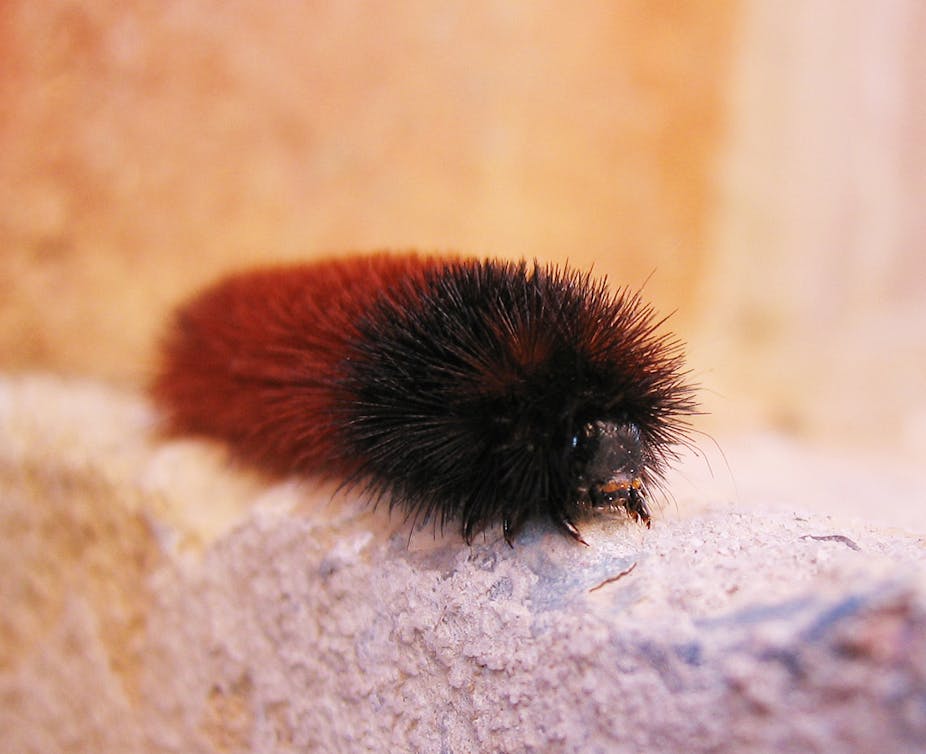On your next stroll through the winter wood, peak under a log and gently brush away the frozen leaves. Beneath, you might find a furry friend you haven’t seen since somewhat warmer days: the woolly bear caterpillar.

Also known as woolly worms, these familiar black and brown-striped caterpillars are larvae of the Isabella Tiger Moth, Pyrrharctia isabella. In autumn, woolly bears migrate in astonishing hordes of thousands looking for a hibernacula: a concealed dark habitat under leaves and logs where they can spend winter hibernating as frozen caterpillars. Yes, literally frozen, like ice cubes. These insects produce a natural antifreeze, or cryoprotectant, to protect their cells from the destructive force of ice crystals.

Long before satellites and weather models, people looked to nature for clues to predict the upcoming harshness of the coldest, darkest days of the year. The roly-poly woolly bear caterpillar, common throughout the United States, earned a reputation as a furry meteorologist that could predict severity of the impending winter. Folklore says that the more prominent the caterpillar’s brown stripe, the more mild the winter.
As cherished as that traditional wisdom may be, woolly bears are actually terrible weather forecasters. There is little reliable or repeatable evidence linking the severity of winter with the breadth of the woolly’s stripe.
So how do we account for the apparent year-to-year variation in woolly bear stripes? It turns out that while woolly bears can’t predict January’s ski conditions, they can tell us something about the weather. Unfortunately, it was the weather last spring.

Lepidopterists think many environmental factors influence the variation in the breadth of the woolly’s stripe. Perhaps the most influential is the wooly’s growing season.

When the ground warms in the spring, the woollys thaw and begin to crawl again. Each builds a silken cocoon around itself. After several weeks, metamorphosis complete, they emerge as Isabella Tiger Moths. Oddly enough, while people may sidestep plenty of woolly bears all autumn long, many have never seen the moth. They hide in trees and emerge only at night. After only several days, the moths mate, lay eggs and die. The caterpillar cycle begins anew.
An early spring gives woolly bears a head start on the season. As the woolly bear grows and molts, the width of its brown stripe increases. The warmer the past spring, the fatter and wider the stripe – they’ve had that much longer to grow. That’s why you might notice that the fattest woolly bears are often the brownest.
Still every fall people complain “The woolly bears were brown last year, and it was the mildest winter on record! How do you explain that?” Unfortunately, claims such as these can be chalked up to observer bias. If you love mild winters, you may preferentially notice the browner woolly bears more often.

The crawling of woolly bears is not the only beloved winter weather tale. Folklore would have it that bright and intense fall foliage signals a harsh winter to come. (Not true. Like the woolly bear, leaf color is an indication of the current and past weather, not the winter to come.)
Other tidbits of folk wisdom say you can predict the coming winter’s duration by the timing of bird migrations. Or slice into a persimmon’s seed and look to see the predictive shape of a spoon, fork or knife. (Again, that likely has more to do with conditions when the fruit was forming than what’s to come.)
Personally, I love cold, harsh, snowy winters. While I no longer believe that caterpillars can predict the weather, I still can’t help smile when I find an all-black woolly bear caterpillar. Better yet, all-black woolly bears amongst a vivid backdrop of orange and red trees.
It’s hard to let go of beloved folklore.

